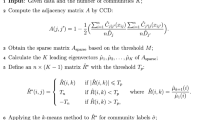Abstract
In this paper, we focus on overlapping community detection and propose an efficient semi-orthogonal nonnegative matrix tri-factorization (semi-ONMTF) algorithm. This method factorizes a matrix X into an orthogonal matrix U, a nonnegative matrix B, and a transposed matrix \(U^\mathrm {\scriptscriptstyle T} \). We use the Cayley Transformation to maintain strict orthogonality of U that each iteration stays on the Stiefel Manifold. This algorithm is computationally efficient because the solutions of U and B are simplified into a matrix-wise update algorithm. Applying this method, we detect overlapping communities by the belonging coefficient vector and analyse associations between communities by the unweighted network of communities. We conduct simulations and applications to show that the proposed method has wide applicability. In a real data example, we apply the semi-ONMTF to a stock data set and construct a directed association network of companies. Based on the modularity for directed and overlapping communities, we obtain five overlapping communities, 17 overlapping nodes, and five outlier nodes in the network. We also discuss the associations between communities, providing insights into the overlapping community detection on the stock market network.




Similar content being viewed by others
Notes
Arthur J.Gallagher &Corporation, Verisk Analytics Incorporated, Aon Corporation, Equity Residential Company, UDR Incorporated.
Abbott Laboratories, Centene Corporation.
Schlumberger Company Limited, Waste Management Incorporated, DTE Energy Corporation, American Electric Power Company Incorporated, Atmos Energy Corporation, AES Corporation.
Tapestry Incorporated, Hershey Company.
Ball Corporation.
Microsoft Corporation.
AutoZone Incorporated, Eversource Energy, Entergy Corporation, Copart Incorporated, Starbucks Corporation.
References
Blondel VD, Guillaume J-L, Lambiotte R, Lefebvre E (2008) Fast unfolding of communities in large networks. J Stat Mech 2008(10):10008
Brunetti C, Harris JH, Mankad S, Michailidis G (2019) Interconnectedness in the interbank market. J Financ Econ 133(2):520–538
Chatterjee S (2021) A new coefficient of correlation. J Am Stat Assoc 116(536):2009–2022
Cichocki A, Zdunek R, Amari S-i (2007) Hierarchical als algorithms for nonnegative matrix and 3d tensor factorization. In: International conference on independent component analysis and signal separation, Springer. vol 4666, pp 169–176
Ding C, Li T, Peng W, Park H (2006) Orthogonal nonnegative matrix t-factorizations for clustering. In: Proceedings of the 12th ACM SIGKDD international conference on knowledge discovery and data mining, pp 126–135
Gong M, Jiang X, Li H, Tan KC (2018) Multiobjective sparse non-negative matrix factorization. IEEE Trans Cybern 49(8):2941–2954
He C, Fei X, Cheng Q, Li H, Hu Z, Tang Y (2021) A survey of community detection in complex networks using nonnegative matrix factorization. IEEE Trans Comput Soc Syst 9(2):440–57
Hestenes MR (1969) Multiplier and gradient methods. J Optim Theory Appl 4(5):303–320
Hu L, Guo G (2020) An augmented Lagrangian alternating direction method for overlapping community detection based on symmetric nonnegative matrix factorization. Int J Mach Learn Cybern 11(2):403–415
Lee DD, Seung HS (1999) Learning the parts of objects by non-negative matrix factorization. Nature 401(6755):788–791
Lee D, Seung HS (2000) Algorithms for non-negative matrix factorization. Advances in neural information processing systems, vol 13
Li H-J, Bu Z, Wang Z, Cao J (2020) Dynamical clustering in electronic commerce systems via optimization and leadership expansion. IEEE Trans Ind Inf 16(8):5327–5334
Li Y, Zhu R, Qu A, Ye H, Sun Z (2021) Topic modeling on triage notes with semiorthogonal nonnegative matrix factorization. J Am Stat Assoc 116(536):1609–1624
Newman ME, Girvan M (2004) Finding and evaluating community structure in networks. Phys Rev E 69(2):026113
Nicosia V, Mangioni G, Carchiolo V, Malgeri M (2009) Extending the definition of modularity to directed graphs with overlapping communities. J Stat Mech 2009(03):03024
Palla G, Derényi I, Farkas I, Vicsek T (2005) Uncovering the overlapping community structure of complex networks in nature and society. Nature 435(7043):814–818
Pan RK, Chatterjee N, Sinha S (2010) Mesoscopic organization reveals the constraints governing Caenorhabditis elegans nervous system. PLoS ONE 5(2):9240
Psorakis I, Roberts S, Ebden M, Sheldon B (2011) Overlapping community detection using Bayesian non-negative matrix factorization. Phys Rev E 83(6):066114
Rainone E (2020) The network nature of over-the-counter interest rates. J Financ Mark 47:100525
Wang F, Li T, Wang X, Zhu S, Ding C (2011) Community discovery using nonnegative matrix factorization. Data Min Knowl Disc 22(3):493–521
Wen Z, Yin W (2013) A feasible method for optimization with orthogonality constraints. Math Program 142(1):397–434
Ye F, Chen C, Wen Z, Zheng Z, Chen W, Zhou Y (2020) Homophily preserving community detection. IEEE Trans Neural Netw Learn Syst 31(8):2903–2915
Zhang Y, Yeung D-Y (2012) Overlapping community detection via bounded nonnegative matrix tri-factorization. In: Proceedings of the 18th ACM SIGKDD international conference on knowledge discovery and data mining, pp 606–614
Zhang D, Xu Y, Peng Y, Du C, Wang N, Tang M, Lu L, Liu J (2023) An interpretable station delay prediction model based on graph community neural network and time-series fuzzy decision tree. IEEE Trans Fuzzy Syst 31(2):421–433
Acknowledgements
This work was supported by the National Natural Science Foundation of China (Grant Nos. 12001557,12371281); the Emerging Interdisciplinary Project, Program for Innovation Research, and the Disciplinary Funds of Central University of Finance and Economics.
Author information
Authors and Affiliations
Corresponding author
Additional information
Publisher's Note
Springer Nature remains neutral with regard to jurisdictional claims in published maps and institutional affiliations.
Rights and permissions
Springer Nature or its licensor (e.g. a society or other partner) holds exclusive rights to this article under a publishing agreement with the author(s) or other rightsholder(s); author self-archiving of the accepted manuscript version of this article is solely governed by the terms of such publishing agreement and applicable law.
About this article
Cite this article
Li, Z., Yang, Y. A semi-orthogonal nonnegative matrix tri-factorization algorithm for overlapping community detection. Stat Papers (2024). https://doi.org/10.1007/s00362-024-01537-1
Received:
Revised:
Published:
DOI: https://doi.org/10.1007/s00362-024-01537-1




